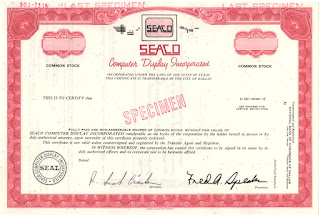The SEACO Computer Display company is a bit of a mystery to me. I was hoping that someone could tell me more about its history.
The style of the stock certificate matches the 1960s. The company name, or its variant with the hyphen, SEACO Computer-Display, does not appear in the '68 volume of Moody's Manual of Industrial Securities. Possibly later editions contain this company profile. Who can tell ?
In the 1970s this Texas-based organization produced microfiche readers and artwork generators, devices that could convert computer data, lettering and digital drawings, to microfiche or microfilm. What puzzles me is the usage of the word Computer in the company name.
When was this business founded and by whom? Did it merge into a successor ?
Was the company involved in design or manufacturing of minicomputers or terminals ?
F.L.


Maybe this will help you with the research?
ReplyDeletehttp://www.bizapedia.com/tx/SEACO-COMPUTERDISPLAY-INCORPORATED.html
Hey thank you HP !
DeleteThis is what that source says :
Seaco Computer-Display Incorporated is a Texas Corporation filed on December 23, 1968. The company seized to exist (involuntary ended). The company's principal address is 410 Kirby Street, Garland, TX 75042-0000.
Maybe this helps (search the text for Seaco)?:
ReplyDeletehttp://www.google.com/patents/US4199815
as it says:
"The SEACO 1601 CRT typesetter, as well as the typesetter disclosed in the U.S. Pat. No. 4,029,947, determine the data required for imaging the character over a range of point sizes from a single set of encoded character outline data by means of a calculation procedure, carried out either by software or hardware."
You might also find this Seaco article interesting:
https://ecse.rpi.edu/courses/F15/ECSE-4770/LAB_2/Controllers.alternative.pdf
Roland Schmidt
Hey Roland, many thanks for the inputs ! I found some other information too : http://ieeexplore.ieee.org/stamp/stamp.jsp?arnumber=5218428
DeleteHere a SEACO system is described that makes use of a computer (third party or self developed ?).
An update of the findings so far:
ReplyDelete1968 Incorporated, Garland, Texas
1969 Seaco Computer-Display Incorporated goes public. Seaco filed a registration statement with the SEC on September 25 seeking registration of 500,000 shares of common stock, to be offered for public sale. The company is primarily engaged in the design and fabrication of high resolution artwork generators. Of the net proceeds of its stock sale, $200,000 will be used to retire bank indebtedness incurred for product development cost, work in process and capital equipment financing for a microfilm computer output printer and a graphics industries typesetter/artwork generator, $800,000 for production of these products, $630,000 to finance capital equipment purchases, working capital requirements and product development cost for a geophysical scant printer, $870,000 for equipment leasing and working capital requirements in connection with entering the design artwork center service business, $150,000 to lend a subsidiary for development of a projection printing optical system and $850,000 to assist in development of other product lines compatible with cathode ray tube display systems. The company has outstanding 1,700,000 common shares of which Fred A. Speaks, president, owns 32%.
1970 Markets its SEACO Model 401 COM Recorder. The system converts computer output (off-line or on-line) to microfilm at rate of 36,000 characters per second / characters and symbols selected from 70-plus set and printed on pages up to 140 characters per line, 64 lines per page / formatting under complete control of operator / lease and service contracts available. One of its customers will be Interface Sciences Corp. of N.Y.C. for delivery of ten Seaco Model 401 Microfilm Recorder Systems at a total price of $441,504.
1970 SEACO SIGNS ON P0LLY III AS ITS FIRST CIM FILM ANALYSIS SYSTEM
Seaco 's first Polly III will be delivered to the University of Toronto's department of physics. The system was originally developed by Argonne National Laboratories.
1970 UNIVERSITY OF BRUSSELS BUYS SEACO CIM DEVICE
SEACO Computer-Display Inc. has been awarded a contract by the Department of High Energy Physics, University of Brussels, Belgium, for delivery of a SEACO Polly III system
1971 Produces the Seaco 1500A CRT artwork generator. The output of a computer system is input to a Seaco 1500A CRT artwork generator to create the photomask master negative. From this negative a photo master is processed. It can be either negative or positive on either film or glass. The system uses a computer (third party or self developed ?) with 8-kb memory. Artwork data can be fed from a magnetic tape unit.
http://ieeexplore.ieee.org/stamp/stamp.jsp?arnumber=5218428
1972 The Model 1601 CRT typesetter is manufactured by SEACO Computer Display in Garland, Tex. This machine stored the absolute coordinates of a number of points on the character outline. Data reduction was achieved because intermediate points on the outline between stored points were considered to follow straight lines between the stored points. The SEACO 1601 CRT typesetter determine the data required for imaging the character over a range of point sizes from a single set of encoded character outline data by means of a calculation procedure, carried out either by software or hardware.
1972 The SEACO 210 microfiche reader has a list price of $149 for the 18Xmodel.
1972 Files for bankruptcy
I worked at Seaco Computer Display from 1970 to 1972 as a wet-behind-the-ears electrical engineer. Seaco tried to branch out from the mask-generation business in 1971, by buying a desktop calculator company that used first-generation digital ICs & Nixie tubes for the readout. Then TI came out with the SR-10 handheld calculator in Nov. 1971, and it was all over for Seaco.
ReplyDeleteThx for the reply. Interesting to know how & why a company wanted to computerize their products
DeleteThank you for everyone that contributed, learned some great things about this company. I'm guessing the 100 stock certificates I found in my late father's office are probably not worth the paper they were printed on now, correct?
ReplyDeleteYou could try to sell one one eBay and find out.
DeleteWell we found 850 shares certificate in my father in-law safe. Guess that's why it was still there bankruptcy.
ReplyDelete